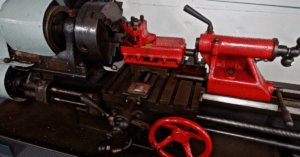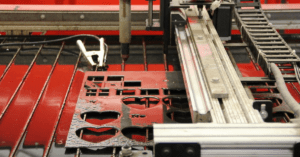
When shopping for a new paint sprayer, you have probably come across the abbreviation “HVLP.” Understanding this type of sprayer is essential to achieve your desired DIY painting results. So we will tell you exactly what is an HVLP spray gun and how it works.
HVLP refers to high volume and low pressure. This paint spray system uses high air volume at low pressure to deliver fine and even paint patterns.
HVLP spray guns offer other benefits to DIY builders, which we will explore in this article. But in order to enjoy these advantages, you will need to learn how to use it, which includes knowing what size air compressor for the HVLP spray gun to use. We will also teach you about these techniques below.
What Is an HVLP Spray Gun?

An HVLP spray gun is among the three types of paint sprayers.
The term HVLP stands for high volume and low pressure. It describes how the spray gun atomizes or breaks up paint coating into particles.
Paint sprayers, including HVLP tools, have different air cap pressure. It can determine how efficient they are at applying paint over various surfaces. Sprayer units with high efficiency use less paint than those with low effectiveness. It results in reduced waste.
An HVLP spray gun uses high air volume at low pressure, typically below 10 PSI. This low-pressure sprayer transfers coating more efficiently. Thus, it wastes less paint than a conventional spray gun and an LVMP model. As an added benefit, an HVLP unit provides finer and smoother finishes.
However, an HVLP paint sprayer is only ideal for certain coatings. For instance, heavy or viscous paint does not work as evenly in HVLP guns. It can lead to peeling finishes over time.
Another downside of using HVLP spray guns is their high price. Since they require more air to atomize coatings, you need to invest in an air compressor. This equipment can set you back a hundred dollars or more, depending on the model.
Below, we briefly list the advantages and disadvantages of HVLP sprayers.
Pros of HVLP Spray Gun
- It can paint more efficiently than other air spray guns
- A higher transfer efficiency means minimal overspray
- The HVLP spray gun delivers a fine and even finish on most surfaces
- It works with different types of air sprayers when attached to a compressor
- It is compatible with various air cap options
- It meets the emissions reduction standards requirements of the EPA
Cons of HVLP Spray Gun
- It is more expensive than a conventional spray gun
- HVLP paint sprayers cannot handle heavy-bodied coats
- It leaves an orange-peel look on the surface when using a highly viscous coating
- The transfer speed is slow due to the lower air pressure involved
How to Use an HVLP Paint Sprayer?
Before using an HVLP spray gun, it is important to know how this device works.
There are two types of HVLP sprayers: dedicated and conversion systems.
Dedicated HVLP spray guns use a turbine to generate airflow. With the help of the high volume and low pressure of air, these sprayers atomize paint at the nozzle outlet.
Meanwhile, conversion systems connect to an air compressor. They transform high-pressure gas to lower-pressure air for a finer and more controlled spray.
Consider the job you intend to complete when you want to use an HVLP paint gun. For instance, you might need to cover a large space. If so, you are better off with a faster gun because low-pressure guns, like the HVLP, tend to be slow.
Once you are sure that you need an HVLP sprayer, fill the gun with paint. Hold it securely and far away from the surface.
Continue spraying the product back and forth using slow strokes. You must also ensure that you have a sufficient air supply for a more controlled spray. Most HPLV sprayers allow you to adjust the pressure by triggering the knob.
What Size of Air Compressor to Use for HVLP Spray Gun?
HVLP guns use a high volume of air to transfer coats effectively. So it is essential to know the correct size of the air compressor for HVLP spray gun systems.
You will need an air compressor with a larger capacity than typical units for DIY applications. Look for a model that can handle up to 75 liters of 20 gallons in its tank.
Besides the tank size, consider the air pressure requirements of your HVLP spray gun. Most systems need 10 to 12 PSI for the correct operation.
After determining the needed pressure, look into the horsepower (HP) rating of the air sprayer. Choose a unit with 2 1⁄2 to 3 HP to meet the required cubic feet per minute (CFM) requirements.
Can You Use Different Materials on an HVLP Sprayer?
You can use an HVLP spray gun to transfer different materials besides regular wall paint. These include the following substances:
- Chalk paint
- Oil paint
- Lacquer
- Primer
- Varnish
- Wood preservative
You can also paint over various surface materials with an HVLP system. It is ideal for wood, clay, ceramics, glass, porcelain, plastic, stone, textile, and metal.
What DIY Projects Are HVLP Spray Guns Suitable For?
As you can use HVLP spray guns with most painting materials and surfaces, they have vast applications in and outside the home.
Below are just a few DIY project examples to do with HVLP paint sprayers.
- Interior and exterior walls
- Doors and windows
- Garage doors
- Ceilings
- Outdoor furniture
- Fences and railings
- Sheds and summer houses
- Decorative objects
What Is The Difference Between HVLP and LVLP Spray Guns?
When looking for a new paint sprayer, you may encounter both HVLP and LVLP systems. Both have their pros and cons, so choosing between the two can be tricky.
We have already covered HVLP above. To reiterate, it stands for high volume and low pressure. It uses high air volume to produce a softer spray. This stain effect is suitable for furniture, doors, and walls. However, HVLP guns only work best with thinner materials, like latex paint, lacquers, and stains. It is not ideal for viscous components and faster applications.
In contrast, an LVLP spray gun uses low air volume and pressure. It features air caps with smaller holes to produce better atomization faster. Thus, the LVLP sprayer performs best with thin stains, varnishes, and clearcoats. It is best suited for large objects and high-production applications.
Conclusion
The HVLP spray gun is among your options when buying a new paint sprayer. Understanding how it works will help you learn if it is the right equipment for your needs.
High-volume low-pressure or HVLP spray guns deliver paint more efficiently than other sprayers. It can produce a fine and smoother surface, ideal for various DIY projects.
Do you have more questions about HVLP sprayers? Let us know via our contact page.






